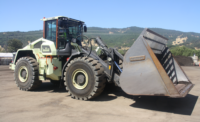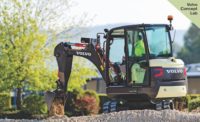The electric hum of a motor and the crunch of gravel under tires were the only audible sounds as a fully autonomous dump truck drove itself along a stretch of road up to a gravel pile at Volvo Construction Equipment’s customer center in Eskilstuna, Sweden.
Building on semi-autonomous technology that already has been deployed on mining sites, Volvo CE is working on prototype designs for fully autonomous equipment in quarrying and earthmoving applications. At a press event on Sept. 14, it showed off some of these latest inventions from the Volvo Concept Lab.
The HX01 prototype autonomous hauler is the latest concept machine in Volvo CE’s vision of a highly efficient quarrying operation. By reducing wasteful processes and increasing the use of electric-driven and autonomous equipment, Volvo engineers estimate that a rock quarry could reduce waste material by 25% and diesel emissions by 95%.
The Volvo HX01 is hardly the first attempt at autonomous haulage, but it is a different approach. Komatsu unveiled a cab-less, autonomous dump truck for mining applications at MineExpo in Las Vegas on Sept. 26. But while that machine is a mining-scale behemoth with a 230- metric-ton payload, the HX01 works at a different scale with its 15-metric-ton capacity. Multiple small machines, operating in concert, are what Volvo engineers envision as the most efficient haulage solution for quarries and earthmoving.
Taking the semi-autonomous machines with fully autonomous driver-assist features, it changes the nature of the job, says Torbjörn Martinsson, an engineer with the Volvo Concept Lab. “As we go into the future with fully autonomous, the operator becomes a supervisor,” he says. “That means the operator is still in the loop but could be watching remotely, getting a higher perspective.”
Martinsson is part of a team that is working to retrofit existing Volvo equipment with autonomous controls. During the demonstration, a Volvo L120E wheel loader performed a load cycle with an A25F articulated dump truck, with no operators present. GPS and radar provided all the reference points the computer needed to complete the task, says Martinsson. “We have a vision system [on the wheel loader], so it knows where the pile is, how it is changing shape.”
The machines get around the site with a combination of preset path-following and GPS navigation. “The hauler follows its path. With the satellite-based navigation on the roof, the accuracy is about 1 centimeter,” says Jimmie Wiklander, engineer with Volvo CE. “It can follow the path with 1 decimeter accuracy while radar detects objects like people and other vehicles.”
Martinsson says the autonomous wheel loader has been working at an asphalt plant, producing over 600 metric tons at the same rate as a skilled operator.
“These autonomous machines will be more productive and more safe than any human-operated machine. They will beat us, and we know how to do it and how to develop it,” says Martinsson.
Getting More Out of Hybrids
Volvo isn’t the first to develop a diesel-electric hybrid wheel loader, but it is setting some ambitious goals for its LX01 prototype machine. “In our test results, we’ve found that machine will improve fuel efficiency by 50%,” says Scott Young, product manager for Volvo CE’s electromobility platform. “That’s versus our conventional machine out there today.”
Volvo showed off a diesel-electric hybrid wheel loader at Conexpo in 2008, but that machine could barely manage 10% improved fuel efficiency, says Young.
The machine today has vastly improved, requiring only a 3.6-liter diesel engine compared to the 13-liter engine on the conventional wheel loader.
The demo machine is being shipped to California, where waste-disposal giant Waste Management will put it through its paces at one of the firm’s transfer stations.
“We run long hours, and we have a lot of idle time,” says John Meese, senior director of heavy equipment for Waste Management. “When we do that, it’s a minimal draw on batteries. But in a diesel unit, you’re still burning gallons of fuel.”
The trial run of the LX01 is part of a pilot program by the California Energy Commission and CALSTART, and Meese thinks the investment will pay off. “We’ve spent a lot of capital trying to keep up with California’s rigid stance on emissions, and this machine will exceed everything they have in the planning stages.”
Meese adds that he is skeptical after being burned by other manufacturers’ diesel-electric promises. “We have to see if it will work in a harsh environment [and] if the operator will accept it,” he says. “It’s very quiet when running, and for some operators, audio cues are a big part of how they run the machine. But, more importantly, will we achieve the environmental results and the financial results? We believe we can hit 50% fuel savings.”








Post a comment to this article
Report Abusive Comment